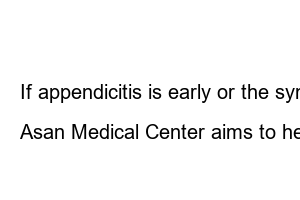맹장 위치 증상Please enter your search term.
turn off autocomplete
If you log in, you can use more various benefits.
Appendicitis refers to inflammation of the 10 cm appendix, which is attached to the transition from the distal end of the small intestine to the large intestine. Most often cause acute abdominal pain requiring surgical excision (acute appendicitis). Occasionally, symptoms recur, which is called recurrent appendicitis.
Appendicitis is caused by obstruction of the appendix by hardened stool, parasites, foreign bodies, or inflammation of the intestine or around the appendix.
More than 95% of people with appendicitis feel abdominal pain (mainly in the right lower abdomen). Vomiting, anorexia, nausea, localized abdominal tenderness, and fever occur in up to 80% of patients. In the case of abdominal pain, pain in the upper abdomen is felt vaguely at first, but gradually develops in the right lower abdomen. Since the location of the appendix differs from person to person, you may experience pain in the right flank. If the appendix is located in the pelvis, symptoms such as wanting to defecate after defecation or vague discomfort above the pubis may appear.
The most common tender point is McBurney’s point located about 5 cm from the right anterior superior pole of the ilium, which corresponds to the normal position of the appendix. The pain may be relieved by bending the right leg and lying down. In addition, symptoms such as constipation and diarrhea may occur.
Appendicitis is diagnosed based on the patient’s symptoms, physical examination, and elevated white blood cells. Abdominal ultrasound and CT scans are helpful in diagnosing appendicitis. In the case of physical examination, palpation of the left lower abdomen causes right lower abdominal pain (Rovsing sign), and rebound tenderness, which intensifies when the hand that pressed the tender point, is observed. Abdominal ultrasonography is useful for diagnosing appendicitis in women of childbearing age and children, as well as for confirming the presence or absence of perforation and abscess formation, and for differentiating it from other diseases. In addition, simple X-rays, blood tests, and urine tests are used.
If appendicitis is early or the symptoms are mild, antibiotic treatment is sometimes performed, but in most cases, the appendix is removed by surgical treatment. Antibiotics are given before and after surgery to reduce the risk of bacterial infection. If inflammation forms an abscess, a drainage tube is inserted and drained without immediate surgery, and antibiotics are administered to reduce the inflammation. After 6 to 12 days, appendectomy is performed.
Postoperative complications occur in 5% to 10% of nonperforated appendicitis and 15% to 65% of those with perforated appendicitis. Since perforation occurs in 20% of patients within 24 hours and 70% within 48 hours after the onset of inflammation, emergency surgery is required. Perforation is more likely to occur in the elderly and in children with an immature serous membrane. Infection is the most common complication. If the infection is severe or an abscess has formed, it can develop in the pelvis, under the diaphragm, or in the abdominal cavity. If the surgical section leaks or if the barrier is weakened, a fistula may develop between the intestine and the skin. Bowel obstruction may occur after surgery. The timing at which these bowel obstructions may appear varies from immediately after surgery to many years after surgery.
Asan Medical Center aims to help create a healthier society by providing reliable health information contents.

